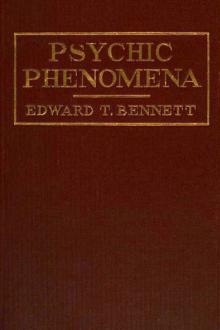The Beautiful by Vernon Lee (red queen free ebook .txt) 📖

- Author: Vernon Lee
- Performer: -
Book online «The Beautiful by Vernon Lee (red queen free ebook .txt) 📖». Author Vernon Lee
Such a shape is therefore, primarily, a series of longer or shorter extensions, given by a separate glance towards, or away from, our own centre or extremities, and at some definite angle to our own axis and to the ground on which we stand. But these acts of extension and orientation cease to be thought of as measured and orientated, and indeed as accomplished, by ourselves, and are translated into objective terms whenever our attention is turned outwards: thus we say that each line is of a given length and direction, so or so much off the horizontal or vertical.
So far we have established relations only to ourselves. We now compare the acts of extension one against the other, and we also measure the adjustment requisite to pass from one to another, continuing to refer them all to our own axis and centre; in everyday speech, we perceive that the various lines are similar and dissimilar in length, direction and orientation. We compare; and comparing we combine them in the unity of our intention: thought of together they are thought of as belonging together. Meanwhile the process of such comparison of the relation of each line with us to the analogous relation to us of its fellows, produces yet further acts of measurement and comparison. For in going from one of our lines to another we become aware of the presence of—how shall I express it?—well of a nothing between them, what we call blank space, because we experience a blank of the particular sensations, say red and black, with which we are engaged in those lines. Between the red and black sensations of the lines we are looking at, there will be a possibility of other colour sensations, say the white of the paper, and these white sensations we shall duly receive, for, except by shutting our eyes, we could not avoid receiving them. But though received these white sensations will not be attended to, because they are not what we are busied with. We shall be passive towards the white sensations while we are active towards the black and red ones; we shall not measure the white; not sweep our glance along it as we do along the red and the black. And as ceteris paribus our tense awareness of active states always throws into insignificance a passive state sandwiched between them; so, bent as we are upon our red and black extensions, and their comparative lengths and directions, we shall treat the uninteresting white extensions as a blank, a gap, as that which separates the objects of our active interest, and takes what existence it has for our mind only from its relation of separating those interesting actively measured and compared lines. Thus the difference between our active perception and our merely passive sensation accounts for the fact that every visible shape is composed of lines (or bands) measured and compared with reference to our own ocular adjustments and our axis and centre; lines existing, as we express it, in blank space, that is to say space not similarly measured; lines, moreover, enclosing between each other more of this blank space, which is not measured in itself but subjected to the measurement of its enclosing lines. And similarly, every audible Shape consists not merely of sounds enclosing silence, but of heard tones between which we are aware of the intervening blank interval which might have been occupied by the intermediary tones and semitones. In other words, visible and audible Shape is composed of alternations between active, that is moving, measuring, referring, comparing, attention; and passive, that is comparatively sluggish reception of mere sensation.
This fact implies another and very important one, which I have indeed already hinted at. If perceiving shape means comparing lines (they may be bands, but we will call them lines), and the lines are measured only by consecutive eye movements, then the act of comparison evidently includes the co-operation, however infinitesimally brief, of memory. The two halves of this Chippendale chair-back exist simultaneously in front of my eyes, but I cannot take stock simultaneously of the lengths and orientation of the curves to the right and the curves of the left. I must hold over the image of one half, and unite it, somewhere in what we call "the mind"—with the other; nay, I must do this even with the separate curves constituting the patterns each of which is measured by a sweep of the glance, even as I should measure them successively by applying a tape and then remembering and comparing their various lengths, although the ocular process may stand to the tape-process as a minute of our time to several hundreds of years. This comes to saying that the perception of visible shapes, even like that of audible ones, takes place in time, and requires therefore the co-operation of memory. Now memory, paradoxical as it may sound, practically implies expectation: the use of the past, to so speak, is to become that visionary thing we call the future. Hence, while we are measuring the extension and direction of one line, we are not only remembering the extent and direction of another previously measured line, but we are also expecting a similar, or somewhat similar, act of measurement of the next line; even as in "following a melody" we not only remember the preceding tone, but expect the succeeding ones. Such interplay of present, past and future is requisite for every kind of meaning, for every unit of thought; and among others, of the meaning, the thought, which we contemplate under the name of shape. It is on account of this interplay of present, past and future, that Wundt counts feelings of tension and relaxation among the elements of form-perception. And the mention of such feelings, i.e. rudiments of emotion, brings us to recognise that the remembering and foreseeing of our acts of measurement and orientation constitutes a microscopic psychological drama—shall we call it the drama of the SOUL MOLECULES?—whose first familiar examples are those two peculiarities of visible and audible shape called Symmetry and Rythm.
Both of these mean that a measurement has been made, and that the degree of its span is kept in memory to the extent of our expecting that the next act of measurement will be similar. Symmetry exists quite as much in Time (hence in shapes made up of sound-relations) as in Space; and Rythm, which is commonly thought of as an especially musical relation, exists as much in Space as in Time; because the perception of shape requires Time and movement equally whether the relations are between objectively co-existent and durable marks on stone or paper, or between objectively successive and fleeting sound-waves. Also because, while the single relations of lines and of sounds require to be ascertained successively, the combination of those various single relations, their relations with one another as whole and parts, require to be grasped by an intellectual synthesis; as much in the case of notes as in the case of lines. If, in either case, we did not remember the first measurement when we obtained the second, there would be no perception of shape however elementary; which is the same as saying that for an utterly oblivious mind there could be no relationships, and therefore no meaning. In the case of Symmetry the relations are not merely the lengths and directions of the single lines, that is to say their relations to ourselves, and the relation established by comparison between these single lines; there is now also the relation of both to a third, itself of course related to ourselves, indeed, as regards visible shape, usually answering to our own axis. The expectation which is liable to fulfilling or balking is therefore that of a repetition of this double relationship remembered between the lengths and directions on one side, by the lengths and directions on the other; and the repetition of a common relation to a central item.
The case of RYTHM is more complex. For, although we usually think of Rythm as a relation of two items, it is in reality a relation of four (or more ); because what we remember and expect is a mixture of similarity with dissimilarity between lengths, directions or impacts. OR IMPACTS. For with Rythm we come to another point illustrative of the fact that all shape-elements depend upon our own activity and its modes. A rythmical arrangement is not necessarily one between objectively alternated elements like objectively longer or shorter lines of a pattern, or objectively higher or lower or longer and shorter notes. Rythm exists equally where the objective data, the sense stimulations, are uniform, as is the case with the ticks of a clock. These ticks would be registered as exactly similar by appropriate instruments. But our mind is not such
 A very interesting statement of one of our contemporaries is that any person, to one degree or another, is both a psychologist and a philosopher - they say, life forces him to. On the one hand, the main driving force of every person is the craving for knowledge, the desire to reach certain social heights, the desire to be wise in any everyday situations - and this is the philosophy of life.
A very interesting statement of one of our contemporaries is that any person, to one degree or another, is both a psychologist and a philosopher - they say, life forces him to. On the one hand, the main driving force of every person is the craving for knowledge, the desire to reach certain social heights, the desire to be wise in any everyday situations - and this is the philosophy of life. 




Comments (0)